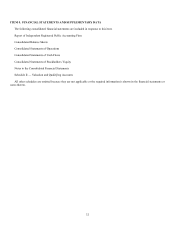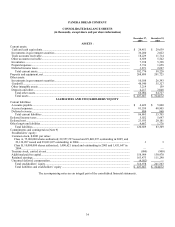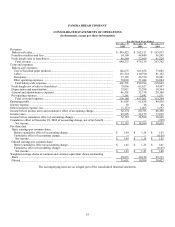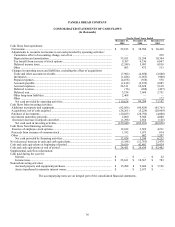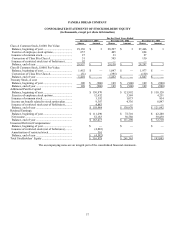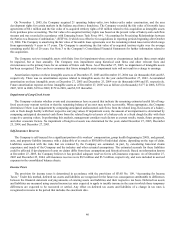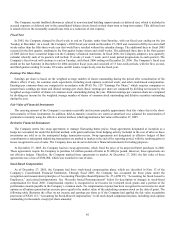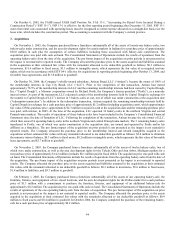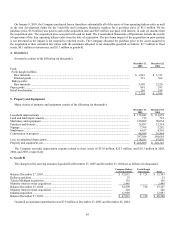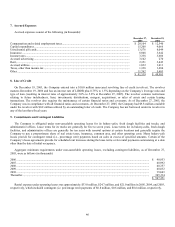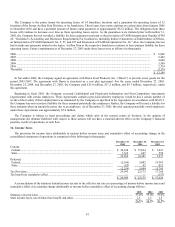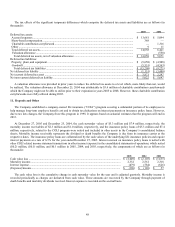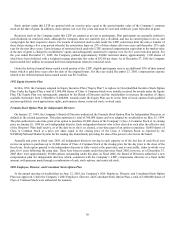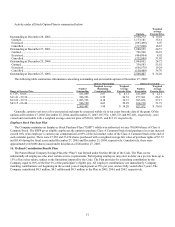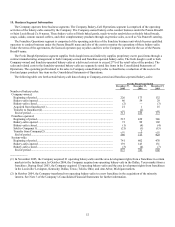Panera Bread 2005 Annual Report Download - page 48
Download and view the complete annual report
Please find page 48 of the 2005 Panera Bread annual report below. You can navigate through the pages in the report by either clicking on the pages listed below, or by using the keyword search tool below to find specific information within the annual report. 42
The Company records landlord allowances related to non-structural building improvements as deferred rent, which is included in
accrued expenses or deferred rent in the consolidated balance sheets based on their short-term or long-term nature. This deferred rent
is amortized over the reasonably assured lease term as a reduction of rent expense.
Fiscal Year
In 2005, the Company changed its fiscal week to end on Tuesday rather than Saturday, with our fiscal year ending on the last
Tuesday in December. As a result, the Company’s 2005 fiscal year ended on December 27, 2005 and consisted of fifty-two and a half
weeks rather than the fifty-three week year that would have resulted without the calendar change. The additional days in fiscal 2005
occurred in the first quarter, resulting in the first quarter being sixteen and a half weeks. The additional three days in the first quarter
of 2005 did not have a material impact on the Company’s financial statements. In fiscal 2006, the Company adopted a new quarterly
calendar whereby each of its quarters will include 13 weeks (4 week, 5 week, and 4 week period progressions in each quarter). The
Company’s fiscal week will continue to end on Tuesday, with fiscal 2006 ending on December 26, 2006. The Company’s fiscal year
ended on the last Saturday in December for 2004 and prior fiscal years and consisted of 13 four-week periods, with the first, second,
and third quarters ending 16 weeks, 28 weeks, and 40 weeks, respectively, into the fiscal year.
Earnings Per Share Data
Earnings per share is based on the weighted average number of shares outstanding during the period after consideration of the
dilutive effect, if any, for common stock equivalents, including stock options, restricted stock, and other stock-based compensation.
Earnings per common share are computed in accordance with SFAS No. 128 “Earnings Per Share,” which requires companies to
present basic earnings per share and diluted earnings per share. Basic earnings per share are computed by dividing net income by the
weighted average number of shares of common stock outstanding during the year. Diluted earnings per common share are computed
by dividing net income by the weighted average number of shares of common stock outstanding and dilutive securities outstanding
during the year.
Fair Value of Financial Instruments
The carrying amount of the Company’s accounts receivable and accounts payable approximate their fair values due to the short-
term maturity of these instruments. In addition, held-to-maturity securities are stated at amortized cost, adjusted for amortization of
premiums to maturity using the effective interest method, which approximates fair value at December 27, 2005.
Derivative Financial Instruments
The Company enters into swap agreements to manage fluctuating butter prices. Swap agreements designated at inception as a
hedge are accounted for under the deferral method, with gains and losses from hedging activity included in the cost of sales as those
inventories are sold or as the anticipated hedge transaction occurs. Swap agreements not designated as effective hedges of firm
commitments or anticipated underlying transactions are marked to market at the end of the reporting period, with the resulting gains or
losses recognized in cost of sales. The Company does not invest in derivative financial instruments for trading purposes.
At December 27, 2005, the Company had two swap agreements, which fixed the price of its projected butter purchases in 2006.
These agreements require the Company to purchase 6.8 million pounds of butter at $1.488 per pound. However, these agreements are
not effective hedges. Therefore, the Company marked these agreements to market. At December 27, 2005, the fair value of these
agreements was a loss of $380,000, which was recorded in cost of sales.
Stock-Based Compensation
As of December 27, 2005, the Company had three stock-based compensation plans, which are described in Note 13 of the
Company’s Consolidated Financial Statements. Through fiscal 2005, the Company has accounted for those plans under the
recognition and measurement principles of Accounting Principles Board Opinion No. 25 (APB 25), “Accounting for Stock Issued to
Employees,” and related interpretations. See “Recently Issued Pronouncements” below for description of changes in stock-based
compensation for fiscal 2006. Compensation expense is recognized in net income for restricted stock grants and a portion of the
performance awards payable in the Company’s common stock. No compensation expense has been recognized in net income for stock
options as all option grants had an exercise price equal to the market value of the underlying common stock on the date of grant. The
following table illustrates the effect on net income and earnings per share as if the Company had applied the fair value recognition
provisions of SFAS 123, “Accounting for Stock-Based Compensation,” to all stock-based compensation plans, including stock options
outstanding (in thousands, except per share amounts):


